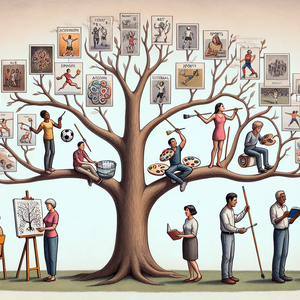The Hidden Disparities of Median Salary Across U.S. States

Several economic indicators contribute to the pronounced differences in median salaries among U.S. states. One of the foremost factors is the cost of living, which varies dramatically across the country. States like California and New York are well-known for their high living costs and, consequently, often report higher median salaries. However, a closer examination reveals that high salaries in these regions may not translate into greater purchasing power. For instance, a software engineer in San Francisco may command a six-figure salary, but the exorbitant housing market and high prices for everyday essentials can significantly erode the real value of that income. Local economies also play a pivotal role in determining salary levels. States with thriving industries tend to offer more competitive wages. For example, Texas, with its booming oil and gas sector, and Washington, home to tech giants like Amazon and Microsoft, typically report higher median salaries. In contrast, states that rely heavily on agriculture or manufacturing, such as Mississippi or Arkansas, often face challenges with lower median salaries due to decreased demand for skilled labor and limited economic diversification.
Personal Stories: The Human Side of Salary Disparities
To better illustrate the impact of these disparities, let’s consider the stories of individuals residing in different states. Take Sarah, a marketing manager in Seattle, Washington, who earns $85,000 a year. While her salary appears substantial, she grapples with a high cost of living, including steep housing prices and significant student loan debt. Comparatively, Jake, who fulfills a similar role in Omaha, Nebraska, earns $60,000. Despite the lower salary, Jake benefits from a significantly lower cost of living, allowing him to live comfortably, enjoy a good quality of life, and save for future aspirations. These narratives highlight how geographical location can profoundly influence not just earnings but also lifestyle and financial security. The experiences of Sarah and Jake emphasize the importance of understanding salary disparities when making career choices or contemplating relocation.
Visualizing the Disparities
To further underscore these disparities, visual representations can be highly effective. Infographics that compare median salaries across all 50 states alongside cost of living indices would provide readers with a clear, impactful view of the economic landscape. For instance, a chart depicting states with high median salaries alongside their corresponding living costs can help individuals quickly grasp the financial realities faced by residents in different regions. Such graphics could also serve as valuable tools for policymakers and educators aiming to address economic inequities.
The hidden disparities of median salaries across U.S. states unveil a multifaceted issue influenced by various economic conditions, cost of living, and industry demands. As individuals navigate their careers and consider relocation, these factors should play a critical role in their decision-making processes. By shedding light on these disparities, we can foster a deeper understanding of the economic landscape and advocate for policies that address these inequalities, ultimately striving for a more balanced and equitable workforce across the nation. The stories of individuals like Sarah and Jake remind us that behind the statistics, real lives are affected by these disparities, underscoring the necessity for awareness and action in addressing economic inequalities. As we continue to explore this topic, it becomes clear that recognizing and addressing these disparities is essential for creating a fairer economic environment for all Americans.
Data Analyst (Regional Economic Research)
Economic research firms, government agencies, and think tanks
Core Responsibilities
Analyze economic data to identify trends and disparities in median salaries across different states.
Create visualizations and reports that communicate findings to stakeholders, including policymakers and business leaders.
Collaborate with local governments and organizations to provide insights on economic development strategies.
Required Skills
Proficiency in statistical software (e.g., R, Python, or SQL) and data visualization tools (e.g., Tableau or Power BI).
Strong analytical and critical thinking skills to interpret complex datasets.
Excellent communication skills to present findings clearly to non-technical audiences.
Compensation and Benefits Analyst
Human resources consulting firms, large corporations, and public sector organizations
Core Responsibilities
Conduct salary benchmarking studies to evaluate competitive pay rates within specific industries and regions.
Analyze employee benefits programs to ensure alignment with market trends and cost-effectiveness.
Prepare reports and recommendations for management regarding compensation adjustments and policy enhancements.
Required Skills
Strong understanding of compensation structures and labor market trends.
Proficiency in Excel and HR management software for data analysis and reporting.
Excellent analytical skills and attention to detail to ensure accurate assessments.
Economic Policy Analyst
Government agencies, non-profit organizations, and policy think tanks
Core Responsibilities
Research and analyze the economic impacts of policies at federal, state, and local levels, with a focus on wage disparities.
Develop policy recommendations based on data-driven insights to address economic inequalities.
Engage with stakeholders, including community organizations and government officials, to advocate for effective policies.
Required Skills
Expertise in economic theory and statistical analysis methods.
Strong writing and presentation skills for creating policy briefs and reports.
Ability to work independently and collaboratively in team environments.
Geographic Information Systems (GIS) Analyst
Urban planning firms, government agencies, and research institutions
Core Responsibilities
Utilize GIS technology to map and analyze geographical data related to median salaries and cost of living across states.
Collaborate with urban planners and economists to provide spatial insights into economic disparities.
Develop interactive maps and visualizations that communicate complex data in an accessible manner.
Required Skills
Proficiency in GIS software (e.g., ArcGIS, QGIS) and spatial analysis techniques.
Strong analytical skills and attention to detail to ensure accurate data representation.
Knowledge of demographics and socio-economic factors influencing geographic trends.
Workforce Development Specialist
Community colleges, non-profit organizations, and workforce development boards
Core Responsibilities
Design and implement programs to enhance workforce skills in areas with low median salaries and limited job opportunities.
Collaborate with local businesses and educational institutions to identify skills gaps and training needs.
Monitor and evaluate program effectiveness in improving employment outcomes for disadvantaged populations.
Required Skills
Strong understanding of labor market trends and workforce development strategies.
Excellent project management skills to oversee training initiatives and partnerships.
Effective communication and interpersonal skills for engaging with diverse stakeholders.


